Sundararaja D. The Discrete Fourier Transform. Theory, Algorithms and Applications
Подождите немного. Документ загружается.


194
DFT Algorithms for Real Data - II
processing tends to become a smaller proportion of the total com-
plexity.
• Between algorithms of the same order of complexity, in general,
the algorithm with better regularity should be preferred even if it
requires slightly more number of arithmetic operations as irregular-
ity also increases execution time in terms of overhead operations.
Therefore, for large N, the indirect use of algorithms for complex
data is preferred. For small N, PM RDFT and PM RIDFT algo-
rithms are preferred, since the arithmetic advantage is significant
and the irregularity may not be a problem as the algorithm can be
implemented as one block in hardware or software. While the user
has to make the final choice for a specific application, we recom-
mend the PM RDFT and PM RIDFT algorithms for N less than
or equal to 16 and the indirect use of algorithms for complex data
for N greater than or equal to 32.
References
(1) Sundararajan, D., Ahmad, M. O. and Swamy, M. N. S. (1994)
"Computational Structures for Fast Fourier Transform Analyzers",
U.S. Patent, No. 5,371,696.
(2) Sundararajan, D., Ahmad, M. O. and Swamy, M. N. S. (1997)
"Fast Computation of the discrete Fourier Transform of Real Data",
IEEE Trans. Signal Processing, vol. 45, No. 8, pp. 2010-2022.
Programming Exercises
9.1 Write a 3-butterfly program to implement the 2 x 1 PM DIT RDFT
algorithm.
9.2 Write a 3-butterfly program to implement the 2 x 1 PM DIF RIDFT
algorithm.
9.3 Write a 3-butterfly program to implement the 2 x 2 PM DIT RDFT
algorithm.
9.4 Write a 3-butterfly program to implement the 2 x 2 PM DIF RIDFT
algorithm.
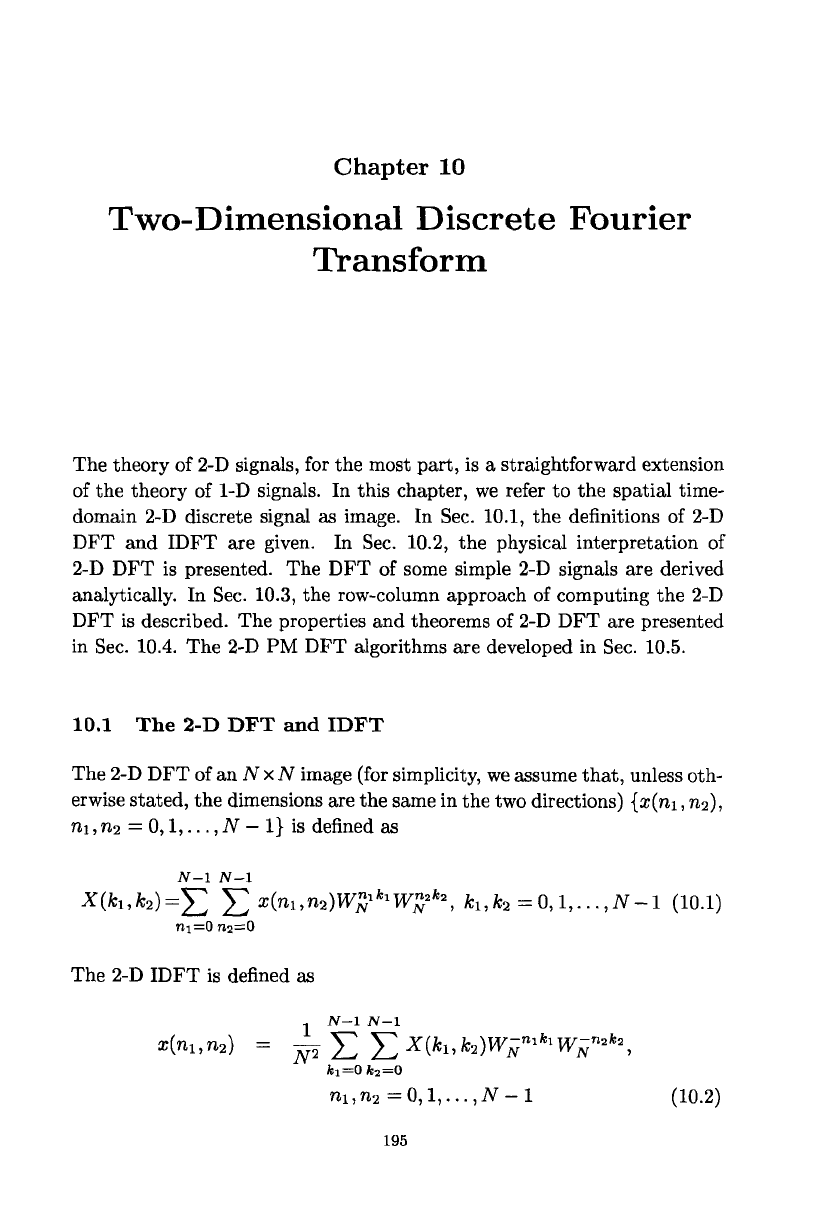
Chapter 10
Two-Dimensional Discrete Fourier
Transform
The theory of 2-D signals, for the most part, is a straightforward extension
of the theory of 1-D signals. In this chapter, we refer to the spatial time-
domain 2-D discrete signal as image. In Sec. 10.1, the definitions of 2-D
DFT and IDFT are given. In Sec. 10.2, the physical interpretation of
2-D DFT is presented. The DFT of some simple 2-D signals are derived
analytically. In Sec. 10.3, the row-column approach of computing the 2-D
DFT is described. The properties and theorems of 2-D DFT are presented
in Sec. 10.4. The 2-D PM DFT algorithms are developed in Sec. 10.5.
10.1 The 2-D DFT and IDFT
The 2-D DFT of an
iV
x
JV
image (for simplicity, we assume that, unless oth-
erwise stated, the dimensions are the same in the two directions) {x(ni, n
2
),
ni,
n
2
=
0,1,...,
N
—
1} is defined as
JV-l N-l
X(k
u
k
2
)=Y,
E
x
(
ni
'
ri2
W*
1
^
2
^i^2=0,l,-,iV-l (10.1)
ni=0 ri2=0
The 2-D IDFT is defined as
.. N-l N-l
*(m,na) = j^Y,
J2
X
^
k
^
W
N
nikxW
N
n2k2
^
ki =0ifc
2
=0
ni,n
2
=0,1,...,7V-1 (10.2)
195

196
Two-Dimensional Discrete Fourier Transform
Center-zero format of the 2-D DFT and IDFT
The 2-D DFT, in the center-zero format with N even, is defined as
X(k
u
k
2
) = £ E
<ri
u
n
2
)W^W^
k
\
«! =
-«-
712
N N
-,
N
,
The 2-D IDFT, in the center-zero format with N even, is defined as
*(m,n
2
) = 4 E E ^i-M^"
1
*
1
^"
2
*
2
,
«1——"2"
«2
——"2"
N N , N
n
n
1
,n
2
= -
T
,-y +
l,...,
y
-l
Getting one format from the other involves the swapping of the quadrants
of the image or the spectrum.
10.2 DFT Representation of Some 2-D Signals
The physical interpretation of the 1-D DFT representation of a signal is that
the signal, which is a curve, is a linear combination of a set of sinusoidal
curves of various frequencies, phase shifts, and amplitudes. The physical
interpretation of the 2-D DFT representation of a signal is that the signal,
which is a surface, is a linear combination of a set of sinusoidal surfaces
of various frequencies, phase shifts, amplitudes, and directions. Given an
image, therefore, the problem of Fourier analysis is the determination of the
coefficients of its constituent sinusoidal surfaces. The problem of Fourier
synthesis is, given the coefficients of a set of sinusoidal surfaces, the building
of the corresponding image. A sinusoidal surface is a stack of shifted
sinusoidal waveforms of the same amplitude and frequency. Assuming N
is even, the constituent sinusoidal surfaces of a real image is obtained from
Eq. (10.2).
x(n
u
n
2
) =
j^{X(0,0)
+ X{-, 0) cos{-K
ni
) + X(0, -) cos(7m
2
)
+ X{-^, y) cos(7r(ni + n
2
))
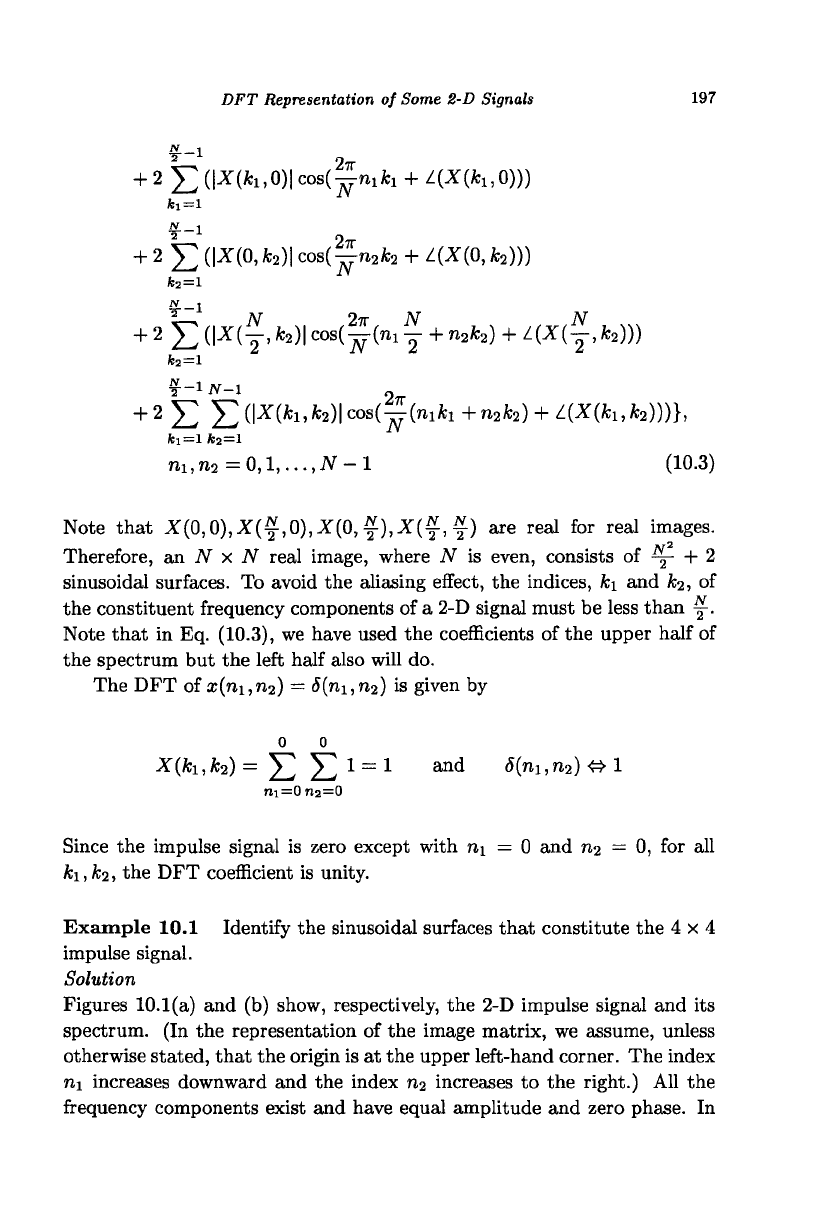
DFT Representation
of
Some
2-D
Signals
197
*
_1
27T
+
2 J2
(l*(*i.O)| cos(— mfci
+
Z(X(fc!,0)))
2
27T
+
2 ^
(|X(0,fc
2
)| cos( —
n
2
fc
2
+
Z(X(0,
fe)))
fe
2
=i
N
y
N 2ir N N
+ 2^(|X(
Y
,fc
2
)|cos(-(n
1
-
+
n
2
fc
2
)
+
Z(X(-,fe
2
)))
fc
2
=i
+
2 ^
^(|X(fc
1
,fc
2
)|cos(-^(n
1
fc
1
+n
2
fe
2
)
+
Z(X(fc
1
,A
;2
)))},
fc
1=
ifc
2
=i
m,n
2
=
0,l,...,iV-l (10.3)
Note that X(0,0),X(f ,0),X(0, f
),X(f,
f) are
real
for
real images.
Therefore,
an N x N
real image, where
TV is
even, consists
of ^- + 2
sinusoidal surfaces.
To
avoid
the
aliasing effect,
the
indices,
fci and fc
2
, of
the constituent frequency components
of a 2-D
signal must
be
less than
y.
Note that
in Eq.
(10.3),
we
have used
the
coefficients
of the
upper half
of
the spectrum
but the
left half also will
do.
The
DFT of
x(ni,n
2
)
=
<5(rii,n
2
)
is
given
by
o
o
X(k
1
,k
2
)= ^2 53
X = 1 and
S(ni,n
2
)<$l
m=0n
2
=0
Since
the
impulse signal
is
zero except with
n\ = 0 and n
2
= 0, for all
&i,fc
2
,
the DFT
coefficient
is
unity.
Example
10.1
Identify
the
sinusoidal surfaces that constitute
the 4x4
impulse signal.
Solution
Figures 10.1(a)
and (b)
show, respectively,
the 2-D
impulse signal
and its
spectrum.
(In the
representation
of the
image matrix,
we
assume, unless
otherwise stated, that
the
origin
is at the
upper left-hand corner.
The
index
ni increases downward
and the
index
n
2
increases
to the
right.)
All the
frequency components exist
and
have equal amplitude
and
zero phase.
In
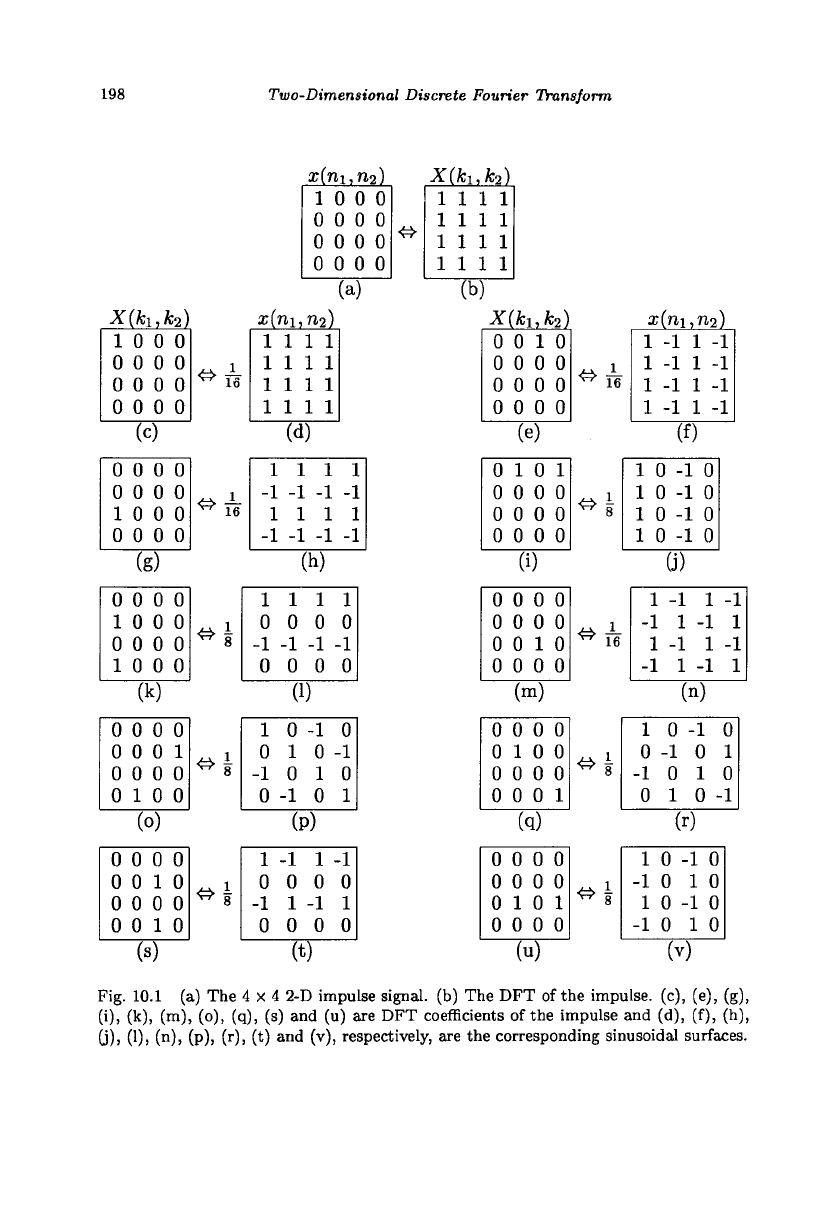
198 Two-Dimensional Discrete Fourier Transform
X(h
1 0
0 0
0 0
0 0
7*2)
0 0
0 0
0 0
0 0
(c)
(g)
(k)
0
0
0
0
0
0
0
1
0
0
0
0
0
1
0
0
(o)
0 0
0 0
0 0
0 0
0
rH
0
rH
0
0
0
0
(s)
*>TS
0
0
1
0
0
0
0
0
0
0
0
0
0
0
0
0
<$
0
1
0
1
0
0
0
0
0
0
0
0
0
0
0
0
W
8
<S>
<$
x{
1
0
0
0
rc,
0
0
0
0
,n
2
)
0
0
0
0
0
0
0
0
(a)
x(ni,n
2
)
1-H
1
1
1
rH
1
1
1
rH
1-H
1
h-i
1
1
1
1
(d)
1
16
rH
-1
1
-1
1
-1
1
-1
1
-1
1
-1
-
-1
1
-1
(h)
1-H
0
-1
0
1
0
-1
0
1 1
0 0
-1 -1
0 0
(1)
1
8
1
0
-1
0
0
1
0
-1
-1
0
1
0
0
-1
0
1
(p)
1
0
-1
0
-1
0
1
0
rH
0
-1
0
T
0
1
0
(t)
t>
X(kufa)
1111
1111
1111
1111
(b)
X
0
0
0
0
(*
0
0
0
0
,fc
2
)
1 0
0 0
0 0
0 0
(e)
0
0
0
0
1
0
0
0
0
0
0
0
1
0
0
0
(i)
0
0
0
0
0
0
0
0
0
0
1
0
0
0
0
0
(m)
0
0
0
0
0
1
0
0
0
0
0
0
0
0
0
1
(q)
0
0
0
0
0
0
1
0
0
0
0
0
0
0
1
0
(u)
w
16
<S>
w
16
<£>
<£>
s(ni,n
2
)
1
1
1
1
-1 1
-1 1
-1 1
-1 1
-1
-1
-1
-1
(f)
1
1
1
1
0
0
0
0
-1
-1
-1
-1
0
0
0
0
(j)
1
-1
1
-1
-1
1
-1
1
1-H
-1
1
-1
-1
1
-1
1
(n)
1
8
1
0
-1
0
0 -1
-1 0
0 1
1 0
0
1-H
0
-1
(r)
1
-1
1
-1
0
0
0
0
-1
1
-1
1
0
0
0
0
(v)
Fig. 10.1 (a) The 4 x 4 2-D impulse signal, (b) The DFT of the impulse, (c), (e), (g),
(i),
(k), (m), (o), (q), (s) and (u) are DFT coefficients of the impulse and (d), (f), (h),
0)i (')> (
n
)>
(P)>
(
r
)> M
an
^ (
v
)> respectively, are the corresponding sinusoidal surfaces.
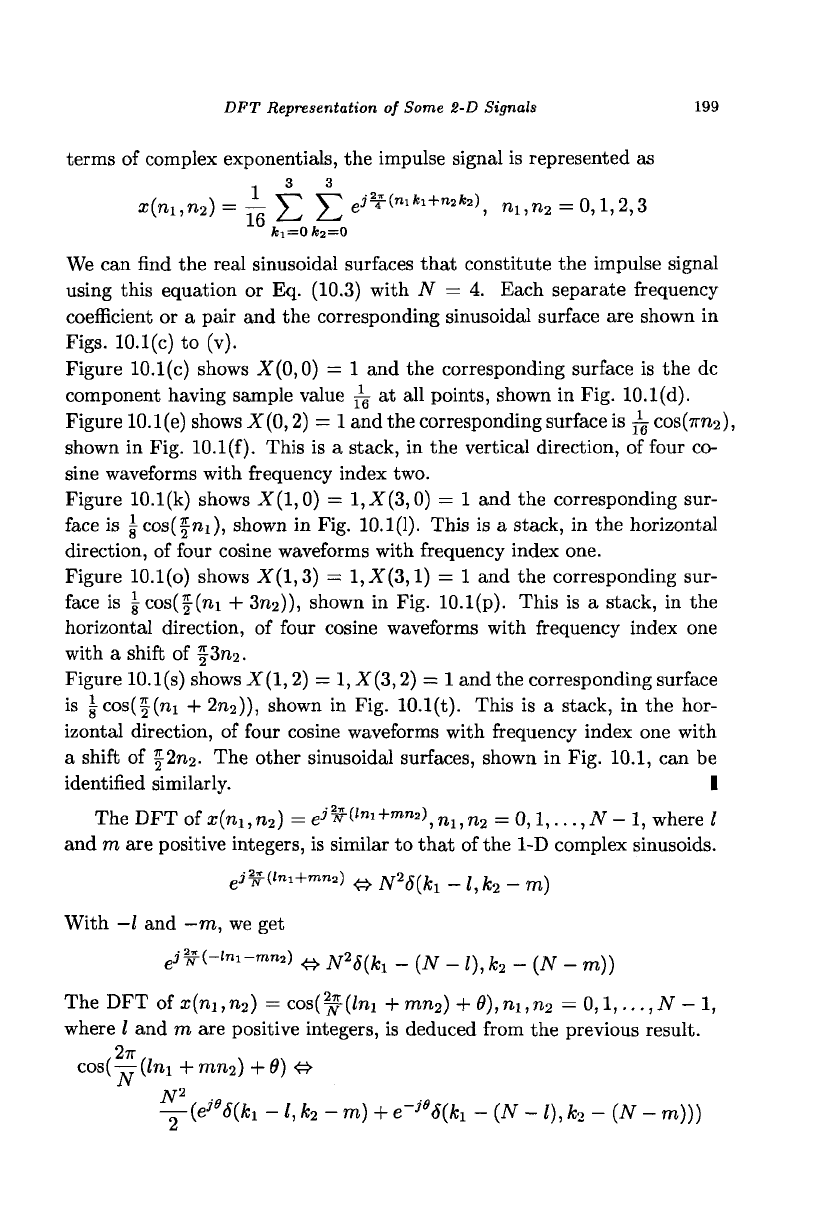
DFT Representation of Some 2-D Signals
199
terms of complex exponentials, the impulse signal is represented as
3 3
*(ni,«2) = i£ ^
e
i»f(m*
1
+n
9
fa)
> ni
,
n2=
0,1,2,3
kr =0*2=0
We can find the real sinusoidal surfaces that constitute the impulse signal
using this equation or Eq. (10.3) with N = 4. Each separate frequency
coefficient or a pair and the corresponding sinusoidal surface are shown in
Figs.
10.1(c) to (v).
Figure 10.1(c) shows X(0,0) = 1 and the corresponding surface is the dc
component having sample value i- at all points, shown in Fig. 10.1(d).
Figure 10.1(e) shows X(0,2) = 1 and the corresponding surface is ^ cos(7rn
2
),
shown in Fig. 10.1(f). This is a stack, in the vertical direction, of four co-
sine waveforms with frequency index two.
Figure 10.1(k) shows X(1,0) =
1,X(3,0)
= 1 and the corresponding sur-
face is |cos(fni), shown in Fig. 10.1(1). This is a stack, in the horizontal
direction, of four cosine waveforms with frequency index one.
Figure 10.1(o) shows X(l,3) =
1,X(3,1)
= 1 and the corresponding sur-
face is |cos(|(ni + 3n
2
)), shown in Fig. 10.1(p). This is a stack, in the
horizontal direction, of four cosine waveforms with frequency index one
with a shift of §3n
2
.
Figure 10.1(s) shows X(l, 2) = 1, X(3,2) = 1 and the corresponding surface
is |cos(|(ni + 2n
2
)), shown in Fig. 10.1(t). This is a stack, in the hor-
izontal direction, of four cosine waveforms with frequency index one with
a shift of |2n2- The other sinusoidal surfaces, shown in Fig. 10.1, can be
identified similarly. I
The DFT of z(m,n
2
) = e^
ini+m
"
2
\ni, n
2
=
0,1,...,
TV
- 1, where I
and m are positive integers, is similar to that of the 1-D complex sinusoids.
e
j^(ln
1+
mn,) ^ ^2^ _
j^
_
m)
With — I and —m, we get
e
i^(-(ni-mn
2
) ^ ^2^ _ ^ _ ^ ^ _
(j
y _
m))
The DFT of x(n
u
n
2
) = cos(^(/m +mn
2
) + 6),n
l
,n
2
=
0,1,..
.,N - 1,
where I and m are positive integers, is deduced from the previous result.
27T
cos( —(Zni + mn
2
) + 6) O-
TV
2
—(e^(J(fci - I, fc
2
- m) + e-
j9
<5(fci - (N - I), h - (JV - m)))
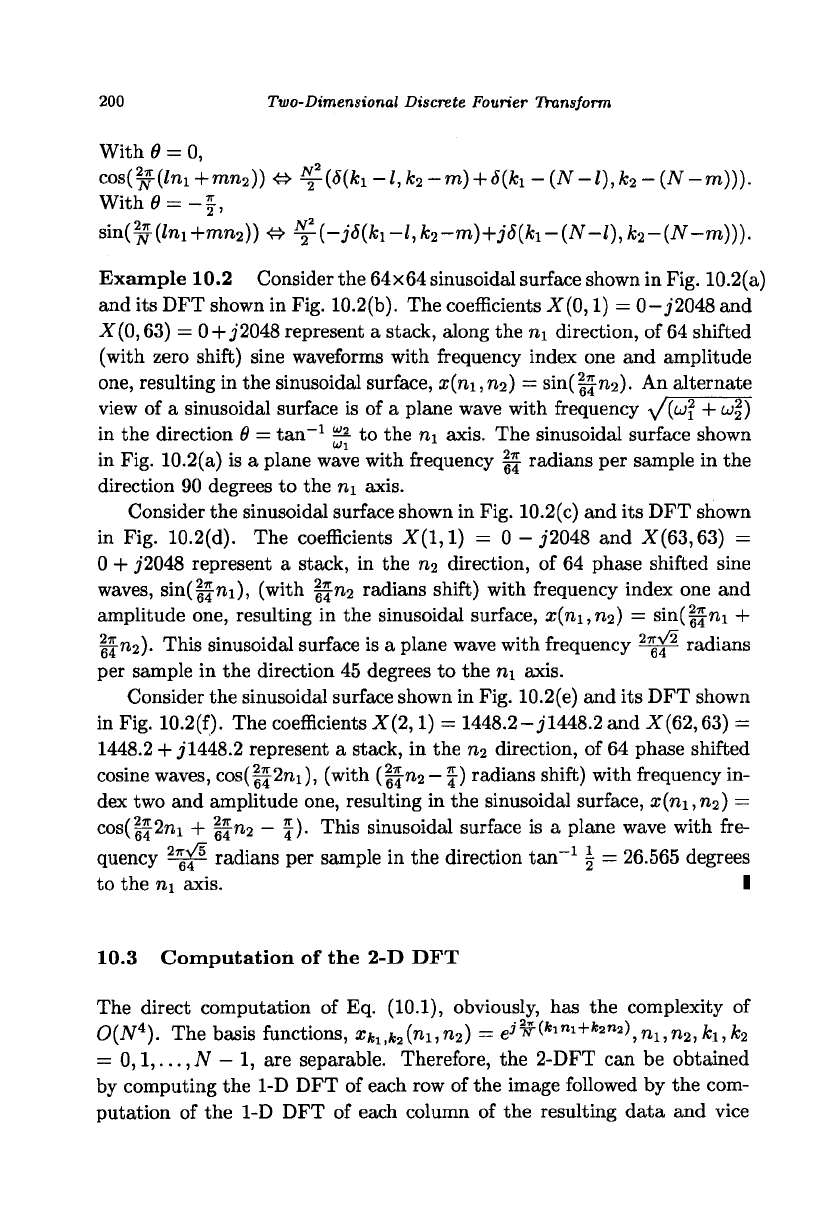
200
Two-Dimensional Discrete Fourier Transform
With 0 = 0,
cos(^(ln
1
+
mn
2
))<^^-(d(ki-l,k
2
-m)
+
6{k
1
-(N-l),k
2
-(N-m))).
With0 = -f,
sin(^(Zm+mn
2
))
<S>
^-(-jS(k
1
-l,k
2
-m)+j6{k
1
-{N-l),k
2
-{N-m))).
Example 10.2 Consider the 64x64 sinusoidal surface shown in Fig. 10.2(a)
and its DFT shown in Fig. 10.2(b). The coefficients X(0,1) = O-j'2048 and
X(0,63) = 0+J2048 represent a stack, along the ni direction, of 64 shifted
(with zero shift) sine waveforms with frequency index one and amplitude
one,
resulting in the sinusoidal surface, x{n\,n
2
) = sin(|yn
2
). An alternate
view of a sinusoidal surface is of a plane wave with frequency \f{u\ + w
2
)
in the direction 6 = tan
-1
^ to the n\ axis. The sinusoidal surface shown
in Fig. 10.2(a) is a plane wave with frequency |f radians per sample in the
direction 90 degrees to the n\ axis.
Consider the sinusoidal surface shown in Fig. 10.2(c) and its DFT shown
in Fig. 10.2(d). The coefficients X(l,l) = 0 - j'2048 and X(63,63) =
0 + j'2048 represent a stack, in the n
2
direction, of 64 phase shifted sine
waves, sin(|jni), (with |fn
2
radians shift) with frequency index one and
amplitude one, resulting in the sinusoidal surface, x(ni,n
2
) = sin(|jni +
|j7i2).
This sinusoidal surface is a plane wave with frequency
2
^
2
radians
per sample in the direction 45 degrees to the n\ axis.
Consider the sinusoidal surface shown in Fig. 10.2(e) and its DFT shown
in Fig. 10.2(f). The coefficients X(2,1) = 1448.2-J1448.2 and X(62,63) =
1448.2 + j'1448.2 represent a stack, in the n
2
direction, of 64 phase shifted
cosine waves, cos(||2ni), (with (§fn
2
—
j) radians shift) with frequency in-
dex two and amplitude one, resulting in the sinusoidal surface, x(ni,n
2
) =
cos(|^2ni + |f
n
2
— \). This sinusoidal surface is a plane wave with fre-
quency 2sxl radians per sample in the direction tan
-1
\ = 26.565 degrees
to the ni axis. I
10.3 Computation of the 2-D DFT
The direct computation of Eq. (10.1), obviously, has the complexity of
0(AT
4
).
The basis functions, ar
fcllfc2
(ni,n
2
) = e^
(
*
ini+
*
2n2)
,ni,n
2
, h, k
2
=
0,1,...,
N — 1, are separable. Therefore, the 2-DFT can be obtained
by computing the 1-D DFT of each row of the image followed by the com-
putation of the 1-D DFT of each column of the resulting data and vice
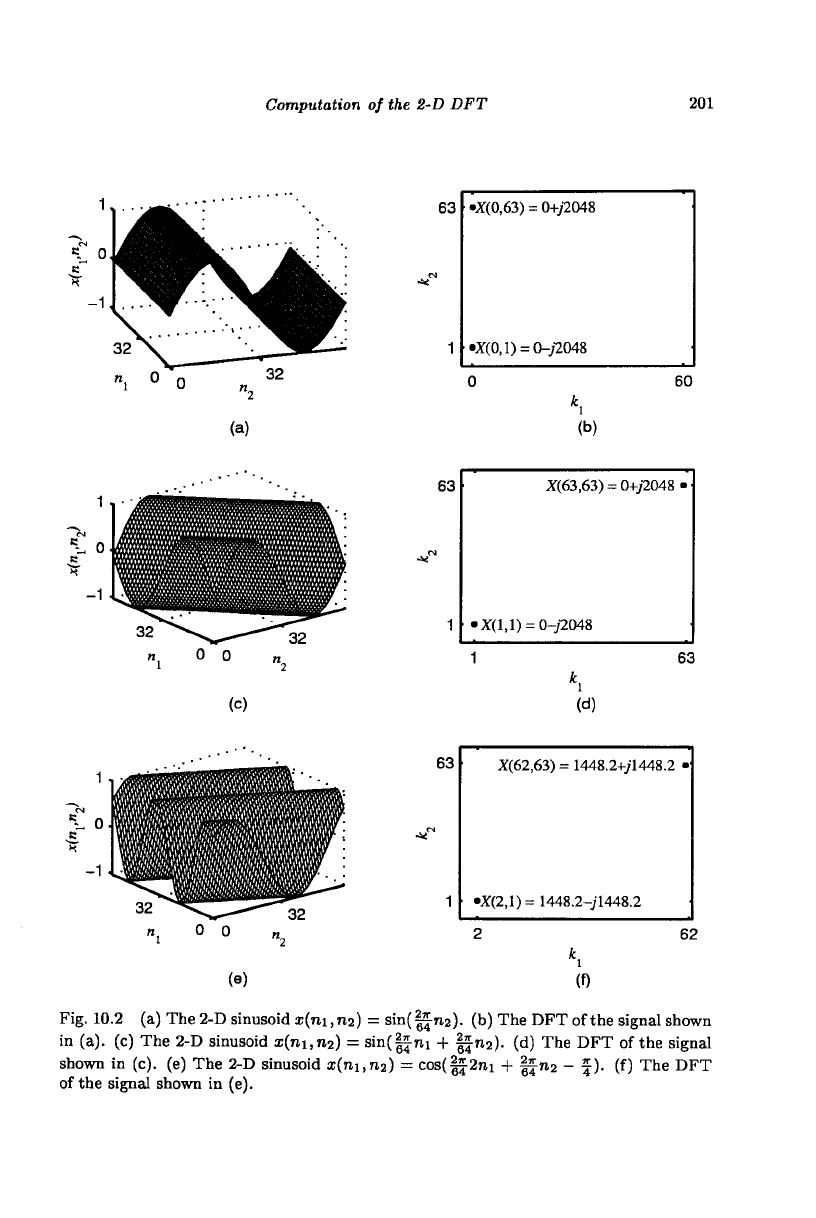
Computation of the 2-D DFT
201
« 0
-1
32
", ° 0
32
63 [ »X(0,63) = 0+/2048
1 f»X(0,l) = 0-;2048
60
(a)
(b)
(c)
63
X(63,63) = 0+/2048
<
1 \ •X(l,l) = 0-;2048
1
63
(d)
63 | X(62,63) = 1448.2+/1448.2
1 f •X(2,l)= 1448.2-;1448.2
62
(•)
(f)
Fig. 10.2 (a) The 2-D sinusoid 1(111,712) = sin(||ri2). (b) The DFT of the signal shown
in (a), (c) The 2-D sinusoid 1(711,712) = sin(||ni + §Jri2). (d) The DFT of the signal
shown in (c). (e) The 2-D sinusoid x(ni,n
2
) = cos(|f 2ni + |jn
2
- \). (f) The DFT
of the signal shown in (e).
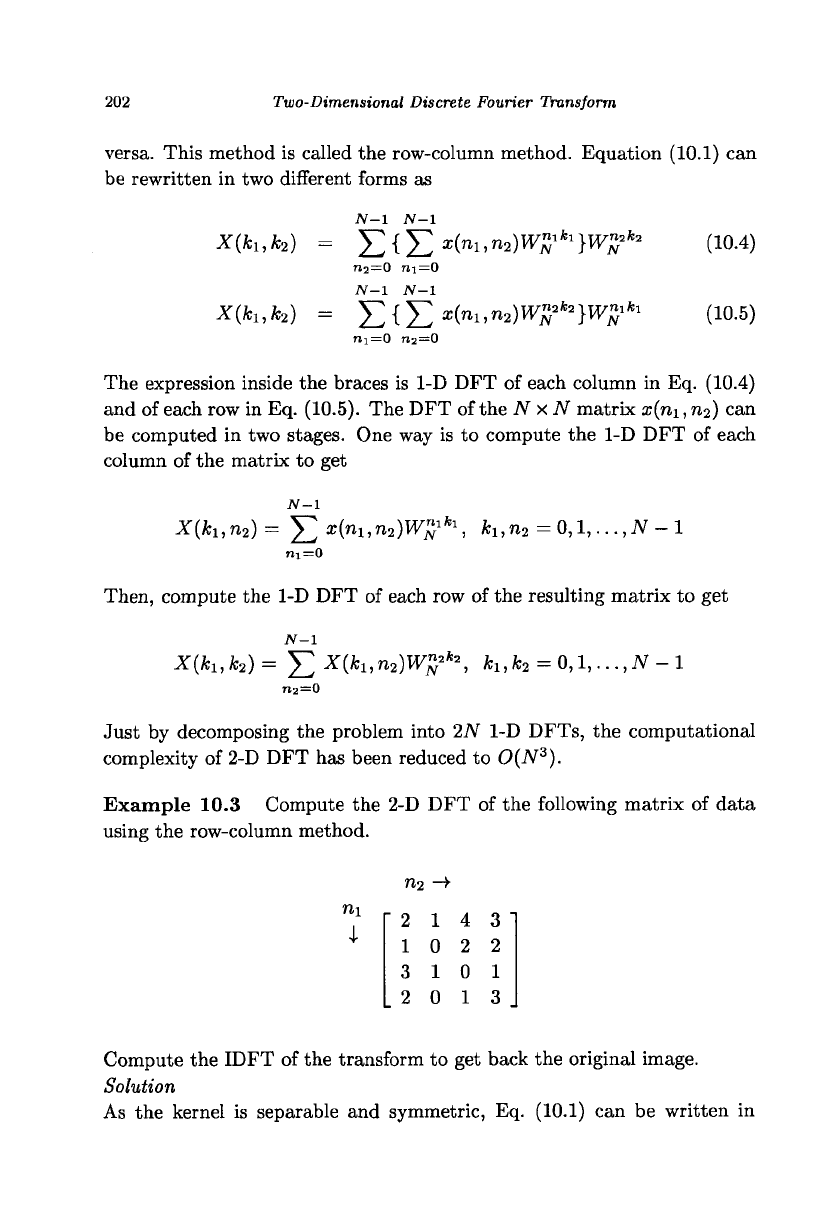
202
Two-Dimensional Discrete Fourier Transform
versa. This method
is
called the row-column method. Equation (10.1) can
be rewritten
in
two different forms
as
JV-l
JV-l
X(k
u
k
2
)
=
X^E^'^TO
1
*
1
}^*'
(10.4)
n
2
=0
m=0
JV-l
JV-l
X(h,k
2
)
= J2{T,
x
^
n
^
W
N
2k2
}
W
N
kl
(10-5)
ni=0 712=0
The expression inside the braces
is
1-D DFT
of
each column
in
Eq. (10.4)
and of each row in Eq. (10.5). The DFT of the
N xN
matrix x(rii,
n
2
)
can
be computed
in
two stages. One way
is to
compute the
1-D
DFT
of
each
column of the matrix
to
get
JV-l
X(h,n
2
)=
^2
x(
ni
,n
2
)W^
k
\
k
lt
Ti2
=
0,l,...,N-l
ni=0
Then, compute the 1-D DFT
of
each row of the resulting matrix
to
get
JV-l
X(h,k
2
)=
J2
x
(
k
uri2)W^
k
\
k
1
,k
2
=
0,l,-..,N-l
712=0
Just
by
decomposing the problem into
2JV
1-D
DFTs,
the
computational
complexity
of
2-D DFT has been reduced
to
0(N
3
).
Example 10.3 Compute
the
2-D DFT
of
the following matrix
of
data
using the row-column method.
n
2
->
2
14 3"
10
2 2
3
10 1
2
0 13.
Compute the IDFT of the transform
to
get back the original image.
Solution
As
the
kernel
is
separable
and
symmetric,
Eq.
(10.1)
can be
written
in
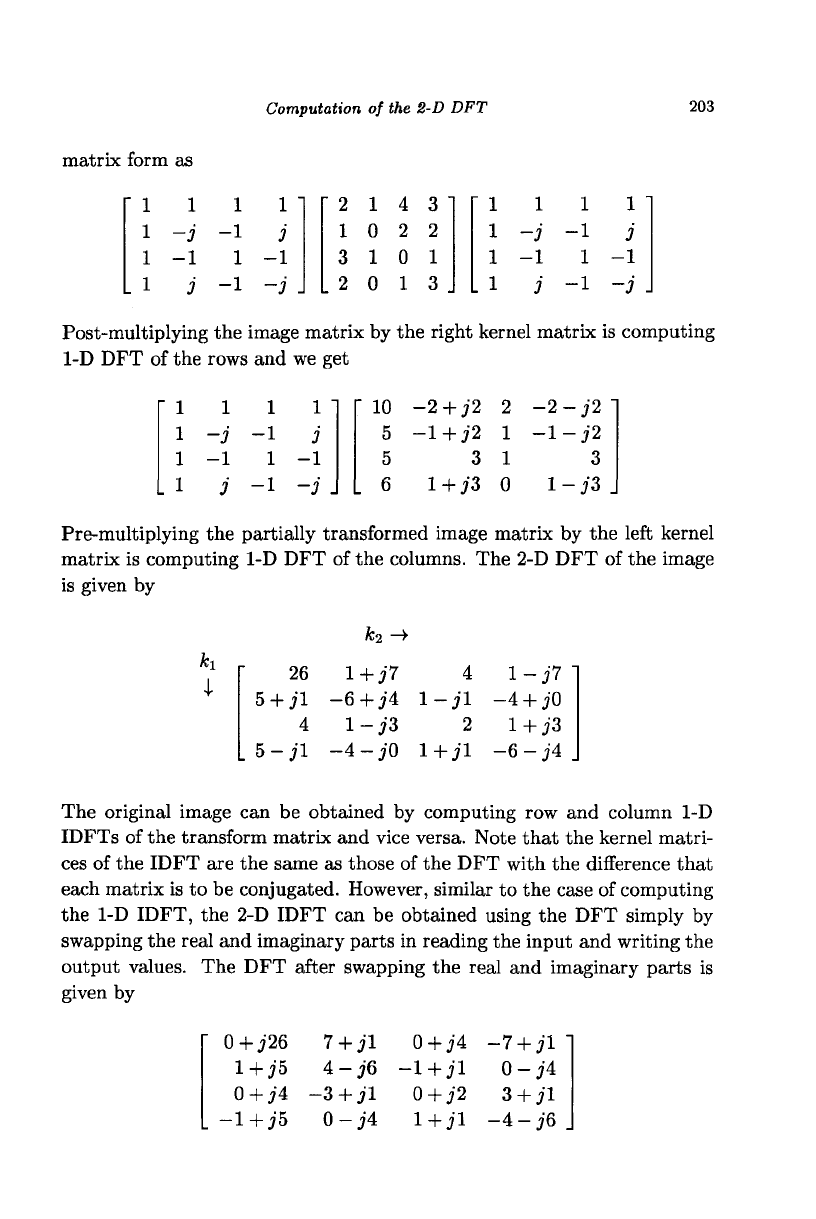
Computation of the 2-D DFT
203
ix form as
" 1 1
1 -3
1 -1
. 1 3
1
-1
1
-1
1 "
3
-1
-3 .
"2143"
10 2 2
3 10 1
.2013.
" 1
1
1
. 1
1
-3
-1
3
1
-1
1
-1
1
3
-1
-3
Post-multiplying the image matrix by the right kernel matrix is computing
1-D DFT of the rows and we get
1
1
1
1
1
-3
-1
3
1
-1
1
-1
1 "
3
-1
-3 .
' 10
5
5
6
-2+J2
-1+J2
3
1+J"3
2
1
1
0
-2-j2
-1-32
3
1-J3
Pre-multiplying the partially transformed image matrix by the left kernel
matrix is computing 1-D DFT of the columns. The 2-D DFT of the image
is given by
26
5 + jl
4
5-jl
l+j'7
-6+j4
1-J3
-4-jO
4
1-J'l
2
1+jl
1-J'7
-4 + jO
1+J3
-6 - j4
The original image can be obtained by computing row and column 1-D
IDFTs of the transform matrix and vice versa. Note that the kernel matri-
ces of the IDFT are the same as those of the DFT with the difference that
each matrix is to be conjugated. However, similar to the case of computing
the 1-D IDFT, the 2-D IDFT can be obtained using the DFT simply by
swapping the real and imaginary parts in reading the input and writing the
output values. The DFT after swapping the real and imaginary parts is
given by
0 + J26
1+J5
O+j/4
-1+J5
7 + jl
4-j6
-3 + jl
0-J4
0 + j4
-1+jl
0+j2
1+jl
-7 + jl
0-j4
3 + jl
-4 - j6
